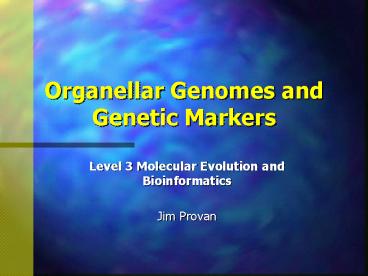Organellar Genomes and Genetic Markers - PowerPoint PPT Presentation
1 / 24
Title:
Organellar Genomes and Genetic Markers
Description:
Majority of Europe colonised from single refugium in the Balkans ... populations probably due to post-glacial recolonisation from a common refugium ... – PowerPoint PPT presentation
Number of Views:184
Avg rating:3.0/5.0
Title: Organellar Genomes and Genetic Markers
1
Organellar Genomes and Genetic Markers
- Level 3 Molecular Evolution and Bioinformatics
- Jim Provan
2
Organellar variation
3
Variation at drift/mutation equilibrium
4
Selective sweeps
5
Plant organelle genomes - implications for markers
- Generally lower diversity due to
- Haploid genome
- Lower mutation rates
- Lack of recombination - selective sweeps
- Lack of intraspecific variation ? species
specific markers - Detection of intraspecific variation ? variable
regions - Non-coding regions
- Tandemly-duplicated genes
- Mononucleotide microsatellites
- Very little mitochondrial variation
6
Genetic change during fragmentation
- In fragmented populations, differentiaton due to
drift will be more marked in haploid organellar
genomes - Maternally inherited markers travel via seed ?
organellar gene flow less substantial
- Maternal markers useful for recording historical
events
7
Ratios of pollenseed flow
- Combined analysis of nuclear and organellar
markers can give information on relative
importance of seed and pollen flow - Important for
- Dynamics of natural populations
- Transgene movement
Wind
Bird
196
Insect
Ruminant
2.5
Wind
Wind
18
8
Animal mitochondrial DNA in population genetics
- Maternal inheritance and relatively rapid rate of
evolution have led to widespread use in studies
of matrilineal gene flow - Sensitive indicator of
- Female-mediated gene flow (maternal inheritance)
- Founder events (haploid genome)
- Comparisons of spatial distribution of nuclear
and mitochondrial markers provides information on
sexual bias in dispersal
9
Geographical structuring with sedentary females
- Offspring from each mother will have maternal
mtDNA genotype and half paternal nuclear genotype - If mothers have different mtDNA genotypes, groups
of offspring will be - Completely different for mitochondrial markers
- At least 50 similar for nuclear markers
10
The Mitochondrial Eve hypothesis
- Studies suggested that between 140,000 and
360,000 years ago, a single mtDNA haplotype
existed! - Theoretical studies dispute this
- Rate of extinction of maternal lineages is high
- Even if several thousand mtDNAs were present,
high probability that only one would have survived
11
Chloroplast DNA phylogeography of Alnus glutinosa
(L.) Gaertn.
- R. Andrew King and Colin Ferris
- Molecular Ecology (1998) 7 1151-1161
12
Introduction
- Until recently, fossil pollen mapping was the
only way to study history of plant populations - Studies in various trees have shown that after
the last (Würrm) glaciation, Europe was
recolonised from at least three separate refugia - Southern Spain
- Southern Italy
- Balkan peninsula
- Use of chloroplast-specific markers should give
new insights into post-glacial histories of plant
species
13
Chloroplast haplotype distribution in alder
(Alnus)
14
Post-glacial history of Alnus
- Obvious high levels of genetic variation below
the southern limit of the ice during the last
glaciation - Two dominant haplotypes found throughout northern
Europe - Majority of Europe colonised from single refugium
in the Balkans
15
Patterns of variation at a mitochondrial
sequence-tagged-site locus provides new insights
into the postglacial history of European Pinus
sylvestris populations
- Nicole Soranzo, Ricardo Alia, Jim Provan and
Wayne Powell - Molecular Ecology (2000) 9 1205-1211
16
Maternal markers in conifers
- In virtually all embryophytes (seed plants), the
mitochondrial genome is inherited maternally i.e.
via the seed - Chloroplast genome inherited in a different
manner in angiosperms and gymnosperms - In angiosperms, chloroplast genome is also mostly
inherited maternally - In gymnosperms, chloroplast genome is inherited
paternally i.e. via both pollen and seed - In conifers, mitochondrial markers will be good
indicators of historical events
17
Mitochondrial variation in Scots pine in Spain
- Two haplotypes found in mitochondrial nadI region
- General NE / SW split in haplotype distribution
- Only one (dark) haplotype found in rest of Europe
18
Distribution of variation in Spanish Pinus
sylvestris
19
Mitochondrial variation in European P. sylvestris
- Levels of population differentiation revealed
using mitochondrial markers were 10- to 30-fold
higher than in previous studies using nuclear and
chloroplast markers - Low degree of variation in non-Spanish
populations probably due to post-glacial
recolonisation from a common refugium - Spanish populations below southern limit of
glaciation - Not subjected to glaciation - represent ancient
gene pools - Physical isolation of populations on different
mountain ranges accounts for high levels of
between-population differentiation
20
rbcL sequences reveal multiple cryptic
introductions of the Japanese red alga
Polysiphonia harveyii
- Lynne McIvor, Christine Maggs, Jim Provan and
Michael Stanhope - Molecular Ecology (2001) 10 911-919
21
Introductions of Polysiphonia harveyii from Japan
- Aim to test whether global populations of P.
harveyii had arisen from a single or multiple
introductions - Methodology
- Sequence rbcL gene
- Align sequences
- Construct phylogenetic tree showing relationships
between observed genotypes - Compare with geographic distribution
22
Minimum-spanning phylogenetic network
23
Multiple introductions of P. harveyii
- Multiple hypothetical ancestral genotypes present
which were not observed - Consistent with Japan being the centre of
diversity of P. harveyii - Most likely not observed due to limited sampling,
rather than extinction - Non-Japanese populations of P. harveyii
represented by two divergent genotypes - One possibly linked to Honshu genotypes
- One possibly linked to Hokkaido genotypes
- Most likely represent at least two separate
introductions from original centre of diversity
in Japan
24
Nuclear and mitochondrial variation in Scots pine
in Sweden
- Scots pine believed to have recolonised Sweden
from both North and South after glaciation
- Nuclear (monoterpene) markers suggest clinal
variation but not definite
- Mitochondrial markers show definite boundary at
60N, even after 50 generations of contact































